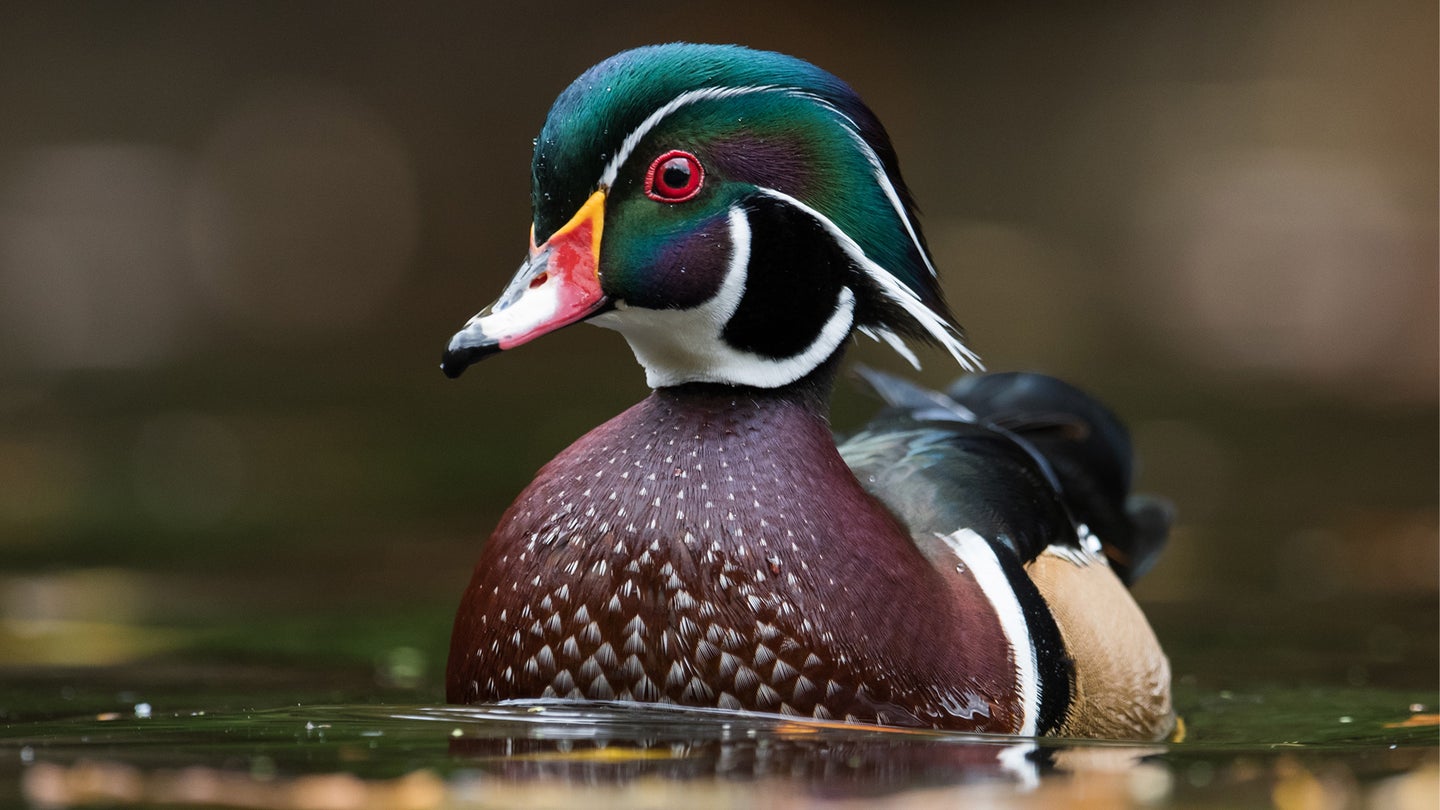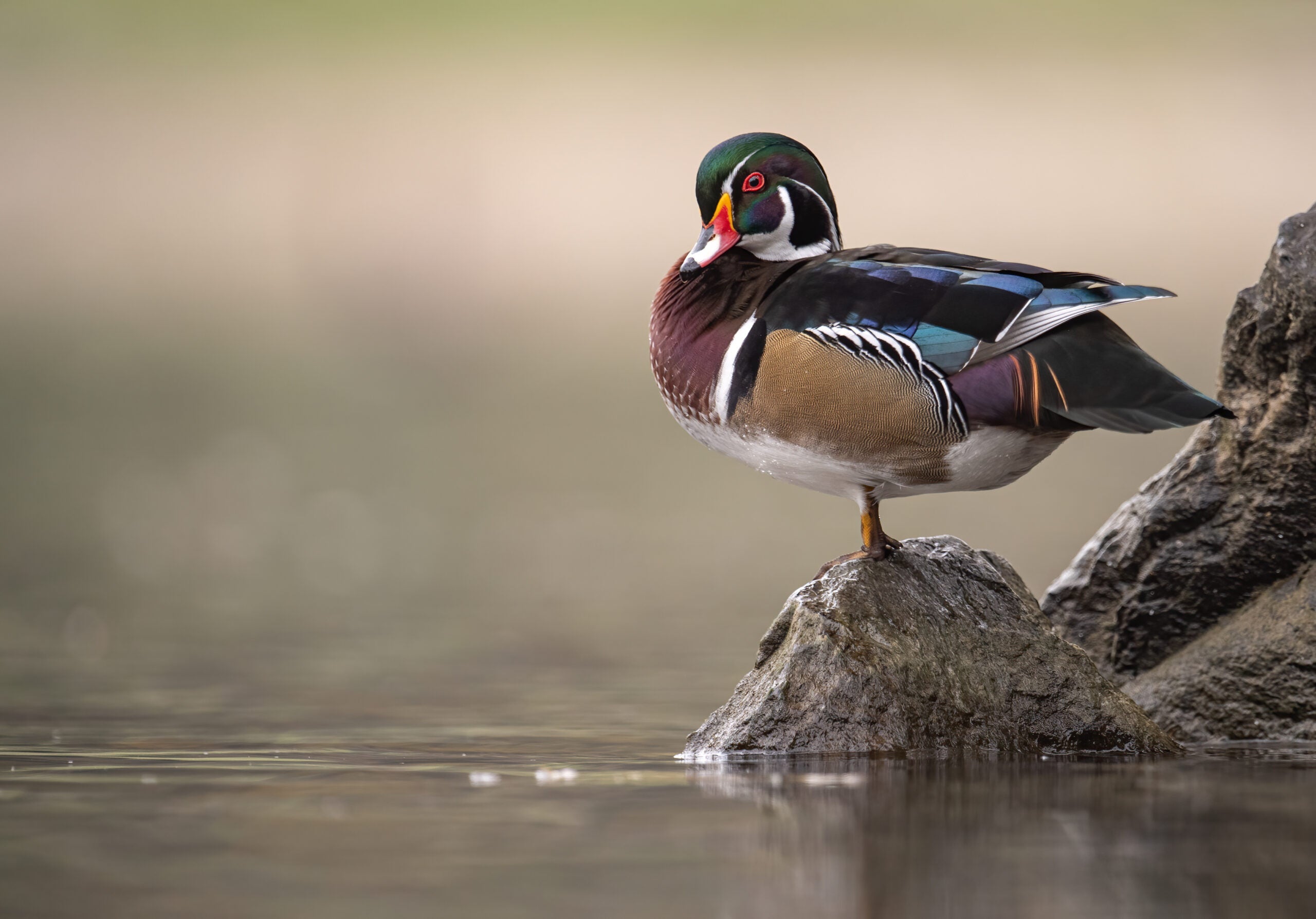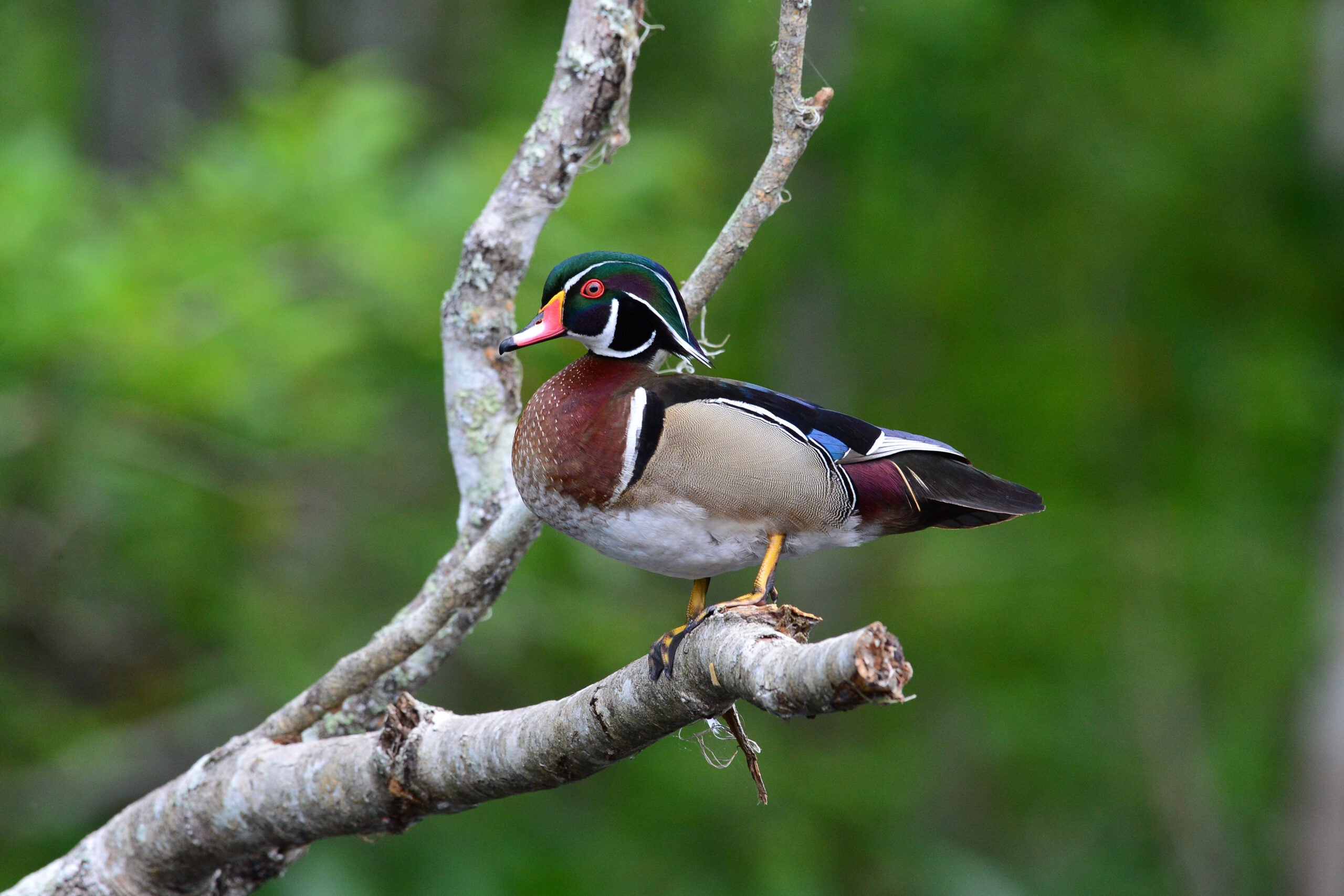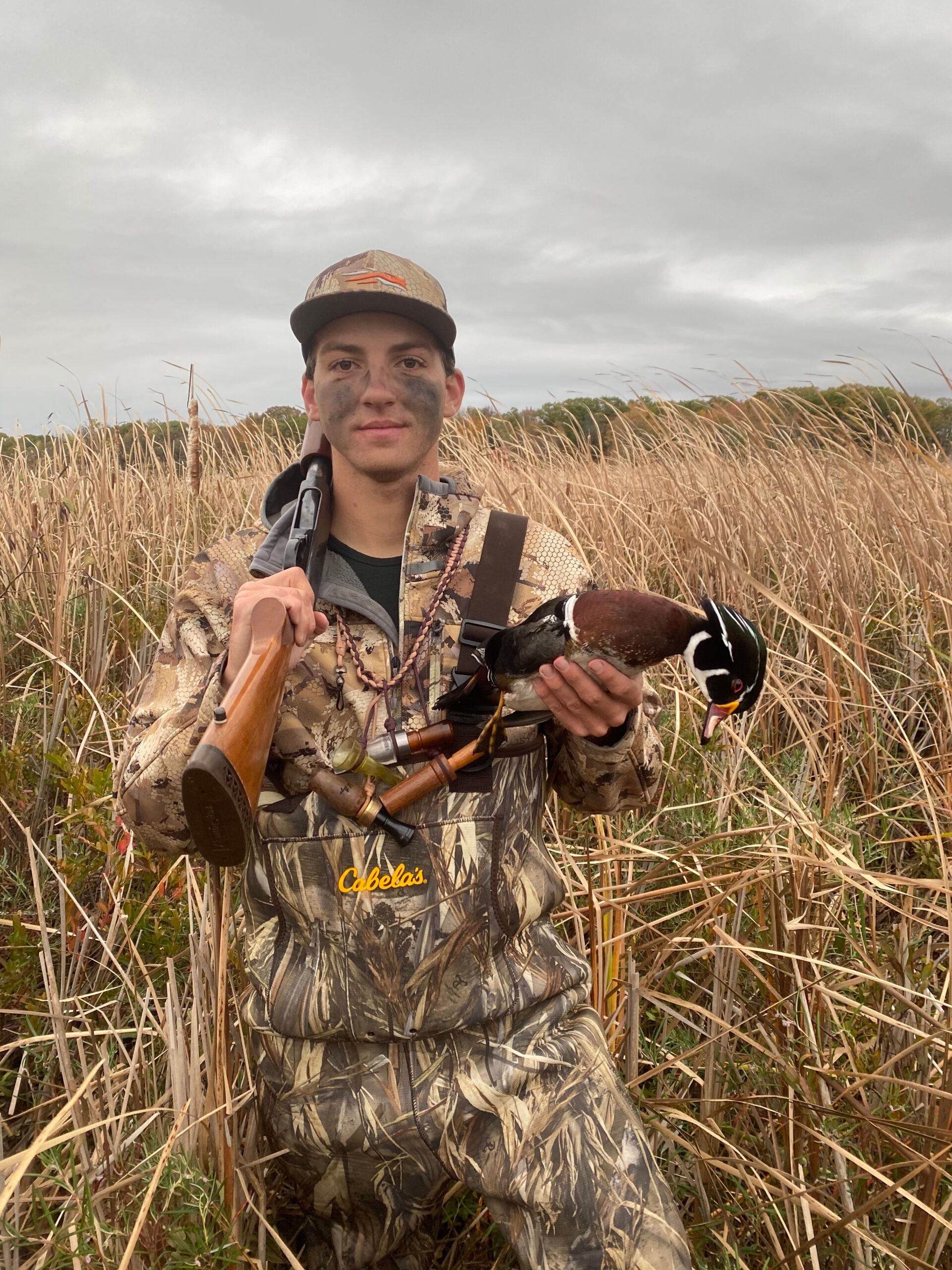
With its crested head and multi-colored plumage, the wood duck lays a claim to the title of America’s prettiest duck. It is also the star of one of America’s greatest conservation comeback stories. Woodies are delicious, their feathers are prized by fly-tiers, they nest in trees, can twist and turn like a ruffed grouse as they fly through the woods, and they squeal instead of quack.
The wood duck is an American original. A perching duck, it’s an inhabitant of woods, creeks, beaver ponds, and tree-lined swamps. They are found in every one of the lower 48 states and range into Ontario and a few other parts of southern Canada. Some winter in Mexico and wood ducks are year-round residents of Cuba. The U.S. states east of the Mississippi form the core of the wood duck’s range. Here is everything else you need to know in order to identify, hunt, and cook this beautiful bird.

Appearance and Calls
The wood duck is easily identified by its crested head, and by the squealing sound it makes in flight and on the water. The drake is boldly colored, with a dark, iridescent green head highlighted with white stripes, a white-flecked chestnut breast, and light brown/tannish sides. The drake’s bill is red and white, and its feet are yellow. That bland description does the drake wood duck’s plumage no justice at all. They are gorgeously colored. The hen is gray-brown overall, with a smaller crest and white teardrop markings on its eyes. With a large head and longer, skinny neck, the wood duck is distinctive in flight, typically holding its head up to look around as it flies.
Woodies make several different sounds, all based on shrill whistling. The drake has a faint whistle and can quack quietly. The hen makes the “ooo-eeek” squealing sound we associate with wood ducks, and there are several other vocalizations.
Feeding Habits and Migration
Wood ducks, like other puddle ducks, feed on aquatic seeds and plants as well as insects, although plant material makes up the vast majority of their diet. They will also feed on dry land, either in grain fields or foraging on the forest floor for berries, acorns, and other nuts.
Woodies in the northern part of their range migrate, often fairly early in the fall compared to hardier ducks. According to Ducks Unlimited, 30 to 75 percent of wood ducks in the eastern and western regions of the United States are year-round residents.

Breeding
While the male’s colorful feathers attract females, some researchers believe that the size of the tear-drop marking on the hen’s head signals age and reproductive potential to prospective suitors. Once wood ducks pair, they search for a nesting site in a tree. Abandoned pileated woodpecker dens make ideal nest sites, as do other holes in dead trees and those made by fallen branches. Woodies will also use man-made nest boxes fixed to the trunks of trees. Hens lay six to 15 eggs, and will also lay in other hen’s nests to increase the chances of their offspring hatching successfully.
The wood duck can hatch two broods a year, so nesting begins early, and the young make the long jump from the nest to the ground when they are one day old. With their soft, young bones, they can survive jumps of up to 50 feet without injury.
Conservation Concerns
Wood ducks were once thought to be on the verge of extinction. Unregulated and sometimes illegal hunting, along with forest clearing, reduced their numbers to alarmingly low levels. From that low, they have rebounded to become one of conservation’s great success stories. Restrictive bag limits and the widespread use of wooden nest boxes helped these birds come back. Populations are healthy enough that a few years ago, the bag limit on wood ducks was raised from two to three.

Wood Duck Hunting
Woodies fly early and late. On the whole, they care little about decoys, either. The best way to hunt them is to scout and find out where they go first thing in the morning and find out where they roost at night. Typically, wood ducks fly down creeks, or to swamps or beaver ponds first thing in the morning. Often, it’s a flurry that begins before legal shooting time and ends a few minutes after. You’ll have bunches of squealing ducks coming in one after another in quick succession, all before it’s too light to see very well. At very first light, being able to see is sometimes more important than being hidden. You can see birds against the sky better than they can see you on the ground. Wood ducks are medium-sized birds and are capable of twisting at high speed through the woods, all of which make the case for an open-choked gun and smaller shot like 4 steel.
Wood ducks will come to a roost site, often a marsh, in the evening by the hundreds. Usually, they come after shooting hours end for the day. Pick the right heavily overcast afternoon, though, and they’ll come during legal light, first in ones and twos, then in bigger groups. Ideally, you shoot two or three right away, then get out and let them come to bed. One of the great pleasures of an evening wood duck hunt is sitting nearby after you limit and watching them swarm into the roost.
The best way to hunt wood ducks between the morning and evening flights is to jump shoot them. This can be accomplished by walking down creeks and peeking into ponds or by floating creeks and rivers in a kayak or canoe, hugging the insides of turns, and hoping to float close enough to get good shots.
It’s not impossible to decoy the occasional woodie. You’ll sometimes shoot them over field spreads on mallard or goose hunts, and if you set a few wood ducks off to the side of your mallards, it can pay off. Wood ducks are also susceptible to spinning-wing decoys. There are special wood duck calls tuned to make the higher squeals of wood ducks. They are most effective on ducks that have landed and are swimming outside of gun range. You can make a whistle that sounds like “weet,” and those ducks will often swim close enough for a good shot.

Cooking Wood Ducks
Woodies have a well-deserved reputation as being among the best table birds. That’s bound to be the case with a duck that feeds on corn and acorns. Wood ducks are often shot early in the season, and those birds will often have a lot of pin feathers and not much fat under the skin. Skin those birds and cook the breasts rare. The fat ducks you shoot later in the season are well worth plucking and roasting whole in a hot oven.
The post Wood Duck: Waterfowling’s Greatest Beauty appeared first on Field & Stream.
Articles may contain affiliate links which enable us to share in the revenue of any purchases made.